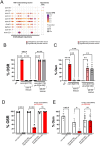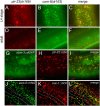This is a preprint.
Soma to neuron communication links stress adaptation to stress avoidance behavior
- PMID: 40654857
- PMCID: PMC12248090
- DOI: 10.1101/2025.05.07.652728
Soma to neuron communication links stress adaptation to stress avoidance behavior
Abstract
In multicellular organisms, signaling from the nervous system to the peripheral tissues can activate physiological responses to stress. Here, we show that inter-tissue stress communication can also function in reverse, i.e. from the peripheral tissue to the nervous system. osm-8 mutants, which activate the osmotic stress response in the C. elegans skin, also exhibit defective osmotic avoidance behavior, which is regulated by the ASH neuronal avoidance circuit. osm-8 osmotic avoidance behavior is completely suppressed by mutation of the Patched/NPC1 homolog ptr-23. The function of osm-8 and ptr-23 in the hypodermal epithelial cells is both necessary and sufficient for directing neuronal osmotic avoidance behavior. Endogenously tagged alleles of osm-8 and ptr-23 co-localize exclusively in the hypodermal lysosomes. Unbiased lipidomic analysis shows that osm-8 leads to a ptr-23-dependent elevation of the lysosome specific lipid bis(monoacylglycero)phosphate (BMP) and expansion of the pool of hypodermal lysosomes. Just as genetic activation of the osmotic stress response by loss of osm-8 in the hypodermis causes an Osm phenotype, acute physiological exposure to osmotic stress also confers a reversible Osm phenotype. Behavioral plasticity requires glycerol production, as mutations in the glycerol biosynthetic enzymes gpdh-1 and gpdh-2 are defective in acquired Osm behavior. While the osm-8 induced Osm behavior requires ptr-23, physiologically induced Osm behavior does not. Instead, both genetic and physiologically induced Osm phenotypes require the unusual non-neuronal lysosomal V-ATPase subunit vha-5, which is also critical for organismal osmotic stress survival. Together, these data reveal that genetic or physiological activation of stress signaling from the skin elicits lysosome-associated signals that modulate the function of a sensory neuron circuit. Such 'body-brain' interoceptive communication may allow organisms to better match neuronal decision-making with organismal physiological state.
Conflict of interest statement
Conflict of Interest Statement The authors have no conflicts of interest to declare
Figures







Similar articles
-
Short-Term Memory Impairment.2024 Jun 8. In: StatPearls [Internet]. Treasure Island (FL): StatPearls Publishing; 2025 Jan–. 2024 Jun 8. In: StatPearls [Internet]. Treasure Island (FL): StatPearls Publishing; 2025 Jan–. PMID: 31424720 Free Books & Documents.
-
The Black Book of Psychotropic Dosing and Monitoring.Psychopharmacol Bull. 2024 Jul 8;54(3):8-59. Psychopharmacol Bull. 2024. PMID: 38993656 Free PMC article. Review.
-
Sexual Harassment and Prevention Training.2024 Mar 29. In: StatPearls [Internet]. Treasure Island (FL): StatPearls Publishing; 2025 Jan–. 2024 Mar 29. In: StatPearls [Internet]. Treasure Island (FL): StatPearls Publishing; 2025 Jan–. PMID: 36508513 Free Books & Documents.
-
Peripuberty Is a Sensitive Period for Prefrontal Parvalbumin Interneuron Activity to Impact Adult Cognitive Flexibility.Dev Neurosci. 2025;47(2):127-138. doi: 10.1159/000539584. Epub 2024 Jun 3. Dev Neurosci. 2025. PMID: 38830346 Free PMC article.
-
Management of urinary stones by experts in stone disease (ESD 2025).Arch Ital Urol Androl. 2025 Jun 30;97(2):14085. doi: 10.4081/aiua.2025.14085. Epub 2025 Jun 30. Arch Ital Urol Androl. 2025. PMID: 40583613 Review.
References
-
- Bargmann C. I., Thomas J. H. and Horvitz H. R., 1990. Chemosensory cell function in the behavior and development of Caenorhabditis elegans. Cold Spring Harb Symp Quant Biol 55: 529–538. - PubMed
Publication types
Grants and funding
LinkOut - more resources
Full Text Sources
Research Materials
Miscellaneous
